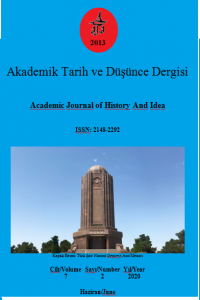تحلیل سبکشناسانۀ دو نامۀ سلطانی کتاب ریاض الانشاء
دوره تیموری با اینکه از جهت کیفیت آثار، در شمار ادوار برجسته ادبی ایران نیست، اما از جهت بسیاریِ ادیبان و شاعران و گسترش ادب، دورهای ممتاز و شایان توجه به شمار میرود. مترسلان و منشیان در حفظ شیوۀ پیشینیان خود کوشش و آثاری متکلفانه خلق میکردند. رقابت در آوردنِ آرایههای ادبی و الفاظ عربی، درواقع در اواخر قرن هفتم و اوایل قرن هشتم به اوج خود رسید. یکی از مهمترین انواع نوشتههای این دوره، منشآت عمادالدین گاوان است. در این پژوهش، ابتدا سیرِ تحول نامههای دیوانی از پیش از اسلام تا دورۀ تیموری بررسی شده است؛ سپس نامههای کتاب ریاض الانشاء به دو بخش سلطانی و غیر سلطانی تقسیم شده است. در این مرحله، دو نوع از نامههای سلطانی مشخص شده است: 1. نامههای سلطانیای که هر دو طرف آن پادشاه است؛ 2. نامههای سلطانیای که منشی برای سلطان نوشته است. نامۀ شماره 86 برای گروه اول و نامۀ شمارۀ 62 برای گروه دوم انتخاب شده است. درنهایت این دو نامه ازنظر ارکان نامههای سلطانی و ویژگیهای سبکی مقایسه خواهد شد. تفاوتهای مهمی میان سبک این دو نوع نامۀ سلطانی وجود دارد: طول نامهها، میزان استفاده از آرایههای مختلف بیانی و بدیعی، نکات زبانی و نحوی، مهمترین تفاوتهای این دو نامه است.
Anahtar Kelimeler:
نامهنگاری, عمادالدین گاوان, ریاض الانشاء
Stylistic analysis of the two Royal letters in Riad-ul- insha
The “Timur” period, although not one of the prominent literary periods in Iran in terms of the quality of its works, But for many writers and poets and the spread of literature, it is a privileged and noteworthy period. Correspondents worked diligently to maintain the style of their predecessors and created compelling works. The competition for literary arrays and Arabic words actually peaked in the late seventh and early eighth centuries. One of the most important types of writings of this period is the letters of Imad-ul- din Mahmoud Gavan. In this study, first, the course of royal letters from pre-Islamic to the “Timur” period has been studied; then the letters of Riad-ul- insha book are divided into two parts, royal and non-royal. At this stage, two types of royal letters are identified.1. Royal letters that both sides are king. 2. 2. Royal letters that the letter writer wrote to the king. Letter No. 86 has been selected for the first group and Letter No. 62 for the second group. Finally, these two letters will be compared in terms of the elements of Royal letters and stylistic features. There are important differences between the styles of these two types of Royal letters: the length of the letters, the amount of use of different literary arrays, linguistic and syntactic points, are the most important differences between these two letters.
Keywords:
Imad-ul- din Mahmoud Gavan, Royal letters, Riad-ul- insha,
___
- SHAFIEI, K., M. R., Adabiat-e farsi az asr-e Jami ta roozgar-e ma, Ney, Tehran, 1378.
- SHAMISA, S., Negahi tazeh be badi, Mitra, Tehran, 1386.
- VAHID, A., Az makatib-e rasool ta rasayel-e abd-ul- hamid va ibn-ul- amid, Sabzevar: Daneshgah-e Tarbiat Mouallim, Sabzevar, 1381.
- YARSHATER, E., Sher-e Farsi dar ahd-e Shahrokh, daneshgah-e Tehran, Tehran, 1383.
- ZARRINKOOB, A., Az gozashte-ye adabi-e Iran, Sokhan, Tehran, 1385.
- Yayın Aralığı: Yılda 6 Sayı
- Başlangıç: 2013
- Yayıncı: Hakan YILMAZ
Sayıdaki Diğer Makaleler
Dışişleri Bakanı Feridun Cemal Erkin Dönemi Türkiye’nin Kıbrıs Politikası (1962-1965)
Latifi Projesi Kapsamında Âşık Sıdkî Baba’nın Şiirleri Üzerine Dijital Bir İnceleme
İstihbarat Kurumlarının Askeri Darbelere Etkisi: Ajax Operasyonu Örneği
Hitit Mektuplarında Kâtiplerin ve Görevlilerin Şahsi Yazışmaları
Azərbaycan-Özbəkistan Əlaqələrində Diaspora Təşkilatlarının Rolu
Hükümet-Dışı Uluslararası Örgütlerin Uluslararası Yargılamadaki Etkisi (Mahkeme Dostları)
Türk Siyasi Hayatında Şeyh Kasım Küfrevi (1920-1992)
Âşık Tipi: Nizâmi Gencevî’nin Leyla ile Mecnun Adlı Mesnevisi
